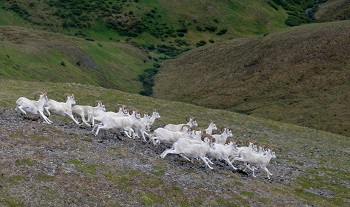Alaska Wildlife
 The BLM Alaska Wildlife Program goal is conservation of wildlife habitat to help ensure self-sustaining populations and a natural abundance, distribution, and diversity of all wildlife. BLM-managed lands are vital to an array of wildlife resources including big game, upland game, predators, waterfowl, shorebirds, songbirds, raptors, non-game mammals, amphibians, pollinators, and other invertebrates. In order to provide for the long-term protection of these wildlife resources, the Wildlife Program supports projects to address the needs of species or suites of species. This landscape approach involves coordination between field offices, districts, state offices and between federal, state, and non-government organization partners to accomplish goals, and coordinated management to better address the needs of wildlife. This includes landscape-scale species (or multi-species) and habitat monitoring, and coordinated habitat improvement or maintenance across populations. When authorizing recreation, mining, energy development, forestry uses, and other activities, the BLM considers the impacts to and accounts for the needs of wildlife and habitat.
The BLM Alaska Wildlife Program goal is conservation of wildlife habitat to help ensure self-sustaining populations and a natural abundance, distribution, and diversity of all wildlife. BLM-managed lands are vital to an array of wildlife resources including big game, upland game, predators, waterfowl, shorebirds, songbirds, raptors, non-game mammals, amphibians, pollinators, and other invertebrates. In order to provide for the long-term protection of these wildlife resources, the Wildlife Program supports projects to address the needs of species or suites of species. This landscape approach involves coordination between field offices, districts, state offices and between federal, state, and non-government organization partners to accomplish goals, and coordinated management to better address the needs of wildlife. This includes landscape-scale species (or multi-species) and habitat monitoring, and coordinated habitat improvement or maintenance across populations. When authorizing recreation, mining, energy development, forestry uses, and other activities, the BLM considers the impacts to and accounts for the needs of wildlife and habitat.
Priority Actions for the Wildlife Program
- Collaborate with State, Federal, and non-government organization partners to leverage technical expertise and financial resources to effectively assess habitat and wildlife populations in need of conservation.
- Develop and share science-based strategies through professional workshops, meetings, and work groups and conduct essential conservation and restoration actions to maintain sustainable healthy biological communities and wildlife of local and regional importance, considering reasons such as aesthetics, education, and ecosystem services.
- Identify, conserve, and restore priority habitats so that they are resilient to environmental stressors, including climate change, drought, wildland fire, and insects/disease.
- Sustain, enhance, and restore wildlife habitat and provide for the needs of species of local and regional priority as determined through collaboration with the State of Alaska, U.S. Fish & Wildlife Service, and other partners.
- Work through the National Environmental Policy Act (NEPA) process to ensure negative wildlife and habitat impacts are addressed in BLM-authorized actions through avoidance, minimization, and mitigation.
- Inventory and monitor species populations and habitat, as well as the success of actions, projects, and treatments in areas targeted for habitat conservation and restoration and ensuring consistent methodologies in delineating habitat and deriving population estimates.
- Coordinate wildlife-related environmental education to stimulate public understanding of the BLM’s role in maintaining and enhancing viable populations of all wildlife and wildlife habitat.
